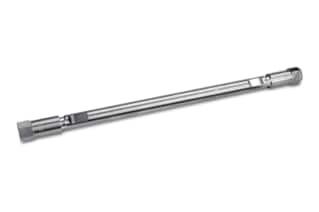
|
Chemistry |
C18 |
|
Separation Mode |
Reversed Phase |
|
Particle Substrate |
Silica |
|
pH Range Min |
2 pH |
|
pH Range Max |
8 pH |
|
Maximum Pressure |
6000 psi (415 Bar) |
|
Endcapped |
Yes |
|
Silanol Activity |
Low |
|
Particle Shape |
Spherical |
|
Particle Size |
3.5 µm |
|
Endfitting Type |
Waters |
|
Pore Size |
100 Å |
|
Format |
Column |
|
Surface Area |
340 |
|
System |
HPLC |
|
USP Classification |
L1 |
|
Inner Diameter |
3 mm |
|
Length |
150 mm |
|
Carbon Load |
16 % |
|
UNSPSC |
41115709 |
|
Brand |
SunFire |
|
Product Type |
Columns |
|
Units per Package |
1 pk |

SunFire C18 Column, 100Å, 3.5 µm, 3 mm X 150 mm, 1/pk
SunFire Columns are state-of-the-art bonded C18 silica HPLC Columns. Waters designed the SunFire Columns after extensive research to provide industry-leading levels of chromatographic performance, representing the best in particle and bonding expertise. SunFire Columns are known for their excellent low-pH stability, high chromatographic efficiency, and superior peak shapes for charged analyte species.
The SunFire C18 Column offers excellent resolution, speed, and low backpressure. It also comes equipped with additional features such as excellent sensitivity, high peak capacity, and ultra-low bleed, which combined, provide you with sharp peaks. With its unique features, this column can be easily used across a wide range of mass spectrometry applications and thus making it a crucial piece of lab equipment to have in any lab.
In contrast to the traditional silica-based HPLC Columns, SunFire C18 Column will provide you with low pH stability, which enhances the column's lifetime. It is an extremely dependable and highly efficient column to have in your lab and provides great sensitivity through Water's proprietary packing technology, state-of-the-art silica synthesis, bonding, and end-capping used in the manufacturing process of the SunFire C18 Column.
With the SunFire C18 Column, you will get symmetrical peaks for improved resolution and quantitation of acidic, neutral, and basic compounds at low and intermediate pH ranges. Find various products that are compatible with the SunFire C18 Column. The website enables you to shop for lab equipment, as well as to reach out with any queries you may have. You can direct these queries and concerns to a member of our staff, located in one of our numerous offices located globally.
Also like SunFire C18 VanGuard Cartridge, 100Å, 3.5 µm, 2.1 mm X 5 mm, 3/pk, SunFire C18 VanGuard Cartridges are used to extend analytical column lifetime and performance by removing particulate contamination from the mobile phase stream. This cartridge is optimized to protect all 2.1 mm and 3.0 mm I.D. SunFire C18 analytical columns containing 3.5 µm sorbent particles.
How Does HPLC Work?
HPLC, known as high-performance liquid chromatography, represents an analytical method employed to effectively separate, identify, and quantify components within a mixture. Renowned as the most widely utilized technique in laboratories worldwide, HPLC serves a myriad of purposes. Its versatility allows for the examination of diverse samples, enabling scientists and researchers to gain valuable insights across multiple domains. From pharmaceutical and biotechnological applications to environmental monitoring and food analysis, HPLC plays a pivotal role in diverse scientific investigations, ensuring accurate and reliable results.
What Is The Principle of Mass Spectrometry?
At its core, mass spectrometry (MS) operates on the fundamental principle of generating ions from a broad range of inorganic or organic compounds through various suitable methods. Subsequently, these ions are separated based on their mass-to-charge ratio (m/z) and can be qualitatively and quantitatively detected using their specific m/z values and relative abundances. This principle forms the basis of mass spectrometry, enabling comprehensive analysis and characterization of compounds in diverse fields such as chemistry, biology, environmental science, and forensics. By elucidating the mass and abundance of ions, mass spectrometry provides valuable insights into molecular structures, isotopic compositions, and compound identification.